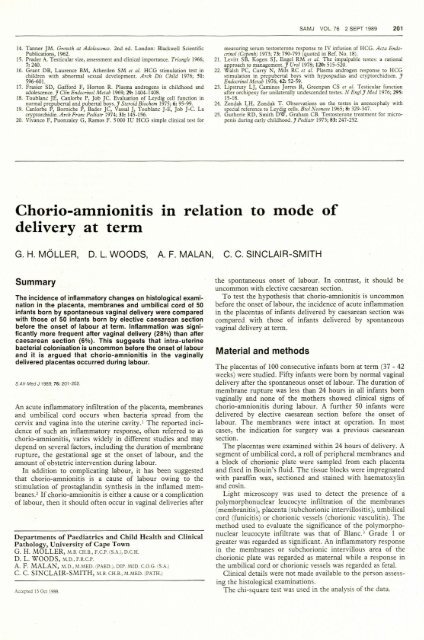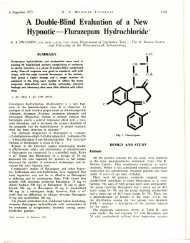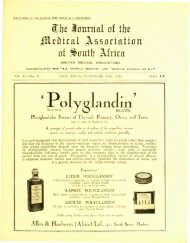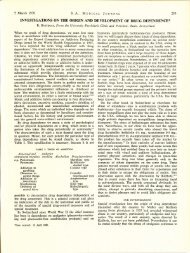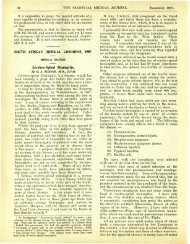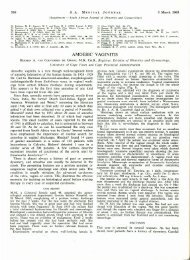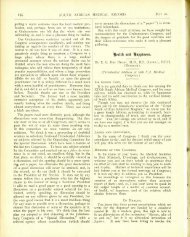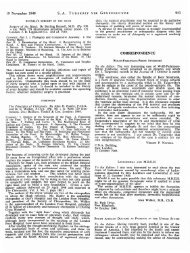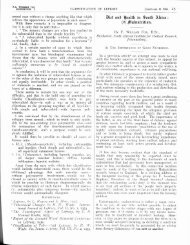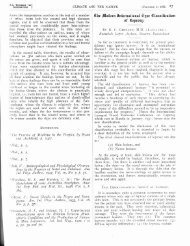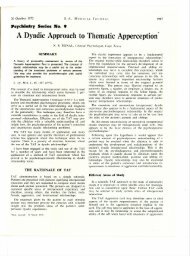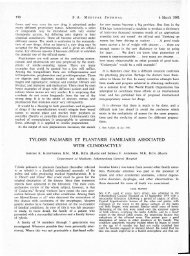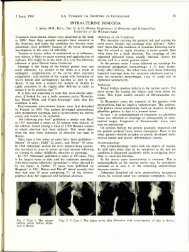Chorio-amnionitis in relation to mode of delivery at term
Chorio-amnionitis in relation to mode of delivery at term
Chorio-amnionitis in relation to mode of delivery at term
You also want an ePaper? Increase the reach of your titles
YUMPU automatically turns print PDFs into web optimized ePapers that Google loves.
SAMJ VOL. 76 2 SEPT 1989 201<br />
14. Tanner JM. Growch ac Adolescence. 2nd ed. London: Blackwell Scientific<br />
Public<strong>at</strong>ions, 1962.<br />
IS. Prader A. Testicular size, assessment and cl<strong>in</strong>ical importance. Triangle 1966;<br />
7: 240.<br />
16. Grant DB, Laurence BM, Atherden SM ec <strong>at</strong>. HCG stimul<strong>at</strong>ion test <strong>in</strong><br />
children with abnormal sexual development. Arch Dis Child 1976; 51:<br />
596-601.<br />
17. Frasier SO, Gafford F, Hor<strong>to</strong>n R. Plasma androgens <strong>in</strong> childhood and<br />
adolescence.] Cl<strong>in</strong> Endocr<strong>in</strong>ol Mecab 1969; 29: 1404-1408.<br />
18. Toublanc JE, Canlorbe P, Job JC Evalu<strong>at</strong>ion <strong>of</strong> Leydig cell function <strong>in</strong><br />
normal prepubertal and pubertal boys.] Sceroid Biochem 1975; 6: 95-99.<br />
19. Canlorbe P, Borniche P, Bader JC, Vassal ], Toublanc J-E, Job J-C La<br />
cryp<strong>to</strong>rchidie. Arch Franc Pediacr 1974; 31: 145-156.<br />
20. Vivanco F, Puonzaley G, Ramos F. 5000 IU HCG simple cl<strong>in</strong>ical teSI for<br />
measur<strong>in</strong>g serum tes<strong>to</strong>sterone response <strong>to</strong> IV <strong>in</strong>fusion <strong>of</strong> HCG. Acca Endocr<strong>in</strong>ol<br />
(Copenh) 1973; 73: 790-793 (quoted <strong>in</strong> Ref. No. 18).<br />
21. Lev<strong>in</strong> SB, Kogen S], Engel RM er al. The impalpable testes: a r<strong>at</strong>ional<br />
approach <strong>to</strong> managemen!.] Uro11978; 120: 515-520.<br />
22. Walsh PC, Curry N, Mils RC ec al. Plasma androgen response <strong>to</strong> HCG<br />
stimul<strong>at</strong>ion <strong>in</strong> prepubertal boys with hypospadias and cryp<strong>to</strong>rchidism. ]<br />
Endocr<strong>in</strong>ol Mecab 1976; 42: 52-59.<br />
23. Lipstruty L], Cam<strong>in</strong>os Jorees R, Greenpan CS ec al. Testicular function<br />
after orchipexy for unil<strong>at</strong>erally undescended testes. N Engl] Med 1976; 295:<br />
15-18.<br />
24. Zondak LH, Zondak T. Observ<strong>at</strong>ions on the testes <strong>in</strong> anencephaly with<br />
special reference <strong>to</strong> Leydig cells. Bioi Neonace 1965; 8: 329-347.<br />
25. Gutherie RO, Smith OW, Graham CB. Tes<strong>to</strong>sterone tre<strong>at</strong>ment for micropenis<br />
dur<strong>in</strong>g early childhood.] Pediacr 1973; 83: 247-252.<br />
<strong>Chorio</strong>-<strong>amnionitis</strong> <strong>in</strong> <strong>rel<strong>at</strong>ion</strong> <strong>to</strong> <strong>mode</strong> <strong>of</strong><br />
<strong>delivery</strong> <strong>at</strong> <strong>term</strong><br />
G. H. MOLLER, D. L. WOODS, A. F. MALAN, C. C. SINCLAIR-SMITH<br />
Summary<br />
The <strong>in</strong>cidence <strong>of</strong> <strong>in</strong>flamma<strong>to</strong>ry changes on his<strong>to</strong>logical exam<strong>in</strong><strong>at</strong>ion<br />
<strong>in</strong> the placenta, membranes and umbilical cord <strong>of</strong> 50<br />
<strong>in</strong>fants born by spontaneous vag<strong>in</strong>al <strong>delivery</strong> were compared<br />
with those <strong>of</strong> 50 <strong>in</strong>fants born by elective caesarean section<br />
before the onset <strong>of</strong> labour <strong>at</strong> <strong>term</strong>. Inflamm<strong>at</strong>ion was significantly<br />
more frequent after vag<strong>in</strong>al <strong>delivery</strong> (28%) than after<br />
caesarean section (6%). This suggests th<strong>at</strong> <strong>in</strong>tra-uter<strong>in</strong>e<br />
bacterial colonis<strong>at</strong>ion is uncommon before the onset <strong>of</strong> labour<br />
and it is argued th<strong>at</strong> chorio-<strong>amnionitis</strong> <strong>in</strong> the vag<strong>in</strong>ally<br />
delivered placentas occurred dur<strong>in</strong>g labour.<br />
S AIr Med J 1989; 76: 201-202.<br />
An acute <strong>in</strong>flamma<strong>to</strong>ry <strong>in</strong>filtr<strong>at</strong>ion <strong>of</strong> the placenta, membranes<br />
and umbilical cord occurs when bacteria spread from the<br />
cervix and vag<strong>in</strong>a <strong>in</strong><strong>to</strong> the uter<strong>in</strong>e cavity. 1 The reported <strong>in</strong>cidence<br />
<strong>of</strong> such an <strong>in</strong>flamma<strong>to</strong>ry response, <strong>of</strong>ten referred <strong>to</strong> as<br />
chorio-<strong>amnionitis</strong>, varies widely <strong>in</strong> different studies and may<br />
depend on several fac<strong>to</strong>rs, <strong>in</strong>clud<strong>in</strong>g the dur<strong>at</strong>ion <strong>of</strong> membrane<br />
rupture, the gest<strong>at</strong>ional age <strong>at</strong> the onset <strong>of</strong> labour, and the<br />
amount <strong>of</strong> obstetric <strong>in</strong>tervention dur<strong>in</strong>g labour.<br />
In addition <strong>to</strong> complic<strong>at</strong><strong>in</strong>g labour, it has been suggested<br />
th<strong>at</strong> chorio-<strong>amnionitis</strong> is a cause <strong>of</strong> labour ow<strong>in</strong>g <strong>to</strong> the<br />
stimul<strong>at</strong>ion <strong>of</strong> prostagland<strong>in</strong> synthesis <strong>in</strong> the <strong>in</strong>flamed membranes.<br />
2 If chorio-<strong>amnionitis</strong> is either a cause or a complic<strong>at</strong>ion<br />
<strong>of</strong> labour, then it should <strong>of</strong>ten occur <strong>in</strong> vag<strong>in</strong>al deliveries after<br />
Departments <strong>of</strong> Paedi<strong>at</strong>rics and Child Health and Cl<strong>in</strong>ical<br />
P<strong>at</strong>hology, University <strong>of</strong> Cape Town<br />
G. H. MOLLER, M.B. CH.B., F.CP (SA), D.CH.<br />
D. L. WOODS, M.D, FRCP<br />
A. F. MALAN, M.D., M.MED. (PAED.), DIP. MID. CO.G. (SA)<br />
C C SINCLAIR-SMITH, M.B. CH.B., M.MED. (PATH.)<br />
Accepled 13 OCI 1988.<br />
the spontaneous onset <strong>of</strong> labour. In contrast, it should be<br />
uncommon with elective caesarean section.<br />
To test the hypothesis th<strong>at</strong> chorio-<strong>amnionitis</strong> is uncommon<br />
before the onset <strong>of</strong> labour, the <strong>in</strong>cidence <strong>of</strong> acute <strong>in</strong>flamm<strong>at</strong>ion<br />
<strong>in</strong> the placentas <strong>of</strong> <strong>in</strong>fants delivered by caesarean section was<br />
compared with those <strong>of</strong> <strong>in</strong>fants delivered by spontaneous<br />
vag<strong>in</strong>al <strong>delivery</strong> <strong>at</strong> <strong>term</strong>.<br />
M<strong>at</strong>erial and methods<br />
The placentas <strong>of</strong> 100 consecutive <strong>in</strong>fants born <strong>at</strong> <strong>term</strong> (37 - 42<br />
weeks) were studied. Fifty <strong>in</strong>fants were born by normal vag<strong>in</strong>al<br />
<strong>delivery</strong> after the spontaneous onset <strong>of</strong> labour. The dur<strong>at</strong>ion <strong>of</strong><br />
membrane rupture was less than 24 hours <strong>in</strong> all <strong>in</strong>fants born<br />
vag<strong>in</strong>ally and none <strong>of</strong> the mothers showed cl<strong>in</strong>ical signs <strong>of</strong><br />
chorio-<strong>amnionitis</strong> dur<strong>in</strong>g labour. A further 50 <strong>in</strong>fants were<br />
delivered by elective caesarean section before the onset <strong>of</strong><br />
labour. The membranes were <strong>in</strong>tact <strong>at</strong> oper<strong>at</strong>ion. In most<br />
cases, the <strong>in</strong>dic<strong>at</strong>ion for surgery was a previous caesearean<br />
section.<br />
The placentas were exam<strong>in</strong>ed with<strong>in</strong> 24 hours <strong>of</strong> <strong>delivery</strong>. A<br />
segment <strong>of</strong> umbilical cord, a roll <strong>of</strong> peripheral membranes and<br />
a block <strong>of</strong> chorionic pl<strong>at</strong>e were sampled from each placenta<br />
and fixed <strong>in</strong> Bou<strong>in</strong>'s fluid. The tissue blocks were impregn<strong>at</strong>ed<br />
with paraff<strong>in</strong> wax, sectioned and sta<strong>in</strong>ed with haema<strong>to</strong>xyl<strong>in</strong><br />
and eos<strong>in</strong>.<br />
Light microscopy was used <strong>to</strong> detect the presence <strong>of</strong> a<br />
polymorphonuclear leucocyte <strong>in</strong>filtr<strong>at</strong>ion <strong>of</strong> the membranes<br />
(membranitis), placenta (subchorionic <strong>in</strong>tervillositis), umbilical<br />
cord (funicitis) or chorionic vessels (chorionic vasculitis). The<br />
method used <strong>to</strong> evalu<strong>at</strong>e the significance <strong>of</strong> the polymorphonuclear<br />
leucocyte <strong>in</strong>filtr<strong>at</strong>e was th<strong>at</strong> <strong>of</strong> Blanc. 3 Grade I or<br />
gre<strong>at</strong>er was regarded as significant. An <strong>in</strong>flamma<strong>to</strong>ry response<br />
<strong>in</strong> the membranes or subchorionic <strong>in</strong>tervillous area <strong>of</strong> the<br />
chorionic pl<strong>at</strong>e was regarded as m<strong>at</strong>ernal while a response <strong>in</strong><br />
the umbilical cord or chorionic vessels was regarded as fetal.<br />
Cl<strong>in</strong>ical details were not made available <strong>to</strong> the person assess<strong>in</strong>g<br />
the his<strong>to</strong>logical exam<strong>in</strong><strong>at</strong>ions.<br />
The chi-square test was used <strong>in</strong> the analysis <strong>of</strong> the d<strong>at</strong>a.
202 SAMT VOL 76 2 SEPT 1989<br />
Results<br />
A m<strong>at</strong>ernal <strong>in</strong>flamma<strong>to</strong>ry response (membranitis or subchorionic<br />
<strong>in</strong>tervillositis) was present <strong>in</strong> 14 vag<strong>in</strong>al deliveries (28%)<br />
and 3 caesarean sections (6%). This difference was significant<br />
(X 2 = 7,09; P < 0,01). Of the 50 placentas delivered vag<strong>in</strong>ally,<br />
membranitis was present <strong>in</strong> 12 and <strong>in</strong>tervillositis <strong>in</strong> 9, with 7<br />
placentas hav<strong>in</strong>g both membranitis and <strong>in</strong>tervillositis. Three <strong>of</strong><br />
the 50 placentas delivered by caesarean section had <strong>in</strong>tervillositis,<br />
<strong>of</strong> which 2 also had a membranitis. In all cases with a<br />
fetal response, a m<strong>at</strong>ernal response was also present.<br />
In contrast, a fetal <strong>in</strong>flamma<strong>to</strong>ry response (funicitis or<br />
chorionic vasculitis) was present <strong>in</strong> the placentas <strong>of</strong> 6 vag<strong>in</strong>al<br />
deliveries (12%) and 3 caesarean sections (6%). This difference<br />
was not significant (X = 2 0,49; P > 0,05). In the vag<strong>in</strong>al<br />
deliveries, funicitis and chorionic vasculitis were present <strong>in</strong> 4<br />
and 5 cases respectively. In the caesarean sections, funicitis<br />
was present <strong>in</strong> all 3 cases, <strong>of</strong> which 2 also had a chorionic<br />
vasculitis. The <strong>in</strong>fants were all cl<strong>in</strong>ically well without signs <strong>of</strong><br />
bacterial <strong>in</strong>fection <strong>at</strong> <strong>delivery</strong>.<br />
A m<strong>at</strong>ernal <strong>in</strong>flamma<strong>to</strong>ry response was therefore significantly<br />
more frequent after vag<strong>in</strong>al <strong>delivery</strong> than caesarean section,<br />
but there was no significant difference <strong>in</strong> the <strong>in</strong>cidence <strong>of</strong> a<br />
fetal response.<br />
Discussion<br />
Dur<strong>in</strong>g pregnancy the <strong>in</strong>tra-uter<strong>in</strong>e cavity and its contents are<br />
usually sterile and the closed cervix is able <strong>to</strong> prevent an<br />
ascend<strong>in</strong>g spread <strong>of</strong> bacteria from the vag<strong>in</strong>a. However, <strong>in</strong><br />
some cases bacteria are able <strong>to</strong> penetr<strong>at</strong>e the cervical barrier<br />
and migr<strong>at</strong>e between the layers <strong>of</strong> the peripheral membranes<br />
<strong>to</strong> reach the placenta. This evokes an acute <strong>in</strong>flamma<strong>to</strong>ry<br />
response by the mother <strong>in</strong> the chorion, amnion and placenta.<br />
L<strong>at</strong>er the bacteria may colonise the amniotic fluid and stimul<strong>at</strong>e<br />
an <strong>in</strong>flamma<strong>to</strong>ry response by the fetus <strong>in</strong> the umbilical and<br />
chorionic vessels. Only occasionally is the fetus <strong>in</strong>fected.<br />
Therefore the newborn <strong>in</strong>fant is usually cl<strong>in</strong>ically well after<br />
<strong>delivery</strong> despite the presence <strong>of</strong> pus cells and bacteria <strong>in</strong> the<br />
gastric aspir<strong>at</strong>e <strong>at</strong> <strong>delivery</strong> and an <strong>in</strong>flamma<strong>to</strong>ry <strong>in</strong>fIltr<strong>at</strong>e ef<br />
the placenta and membranes on his<strong>to</strong>logical exam<strong>in</strong><strong>at</strong>ion.<br />
The ability <strong>of</strong> the cervix <strong>to</strong> prevent the ascend<strong>in</strong>g spread <strong>of</strong><br />
bacteria before the onset <strong>of</strong> labour is supported by this study<br />
where an <strong>in</strong>flamma<strong>to</strong>ry response <strong>in</strong> the placenta, membranes<br />
and umbilical cord was uncommon <strong>in</strong> pregnancies <strong>term</strong><strong>in</strong><strong>at</strong>ed<br />
by elective caesearean section before the onset <strong>of</strong> labour. In<br />
the 3 exceptions, dil<strong>at</strong><strong>at</strong>ion <strong>of</strong> the cervix with exposure <strong>of</strong> the<br />
membranes <strong>to</strong> the vag<strong>in</strong>al flora before the onset <strong>of</strong> contractions<br />
may have allowed colonis<strong>at</strong>ion <strong>of</strong> the uter<strong>in</strong>e cavity.<br />
In contrast, chorio-<strong>amnionitis</strong> was present <strong>in</strong> the placentas<br />
<strong>of</strong> 28% <strong>of</strong> the vag<strong>in</strong>al <strong>delivery</strong> p<strong>at</strong>ients confIrm<strong>in</strong>g th<strong>at</strong> <strong>in</strong>fection<br />
<strong>of</strong> the placenta and membranes is commonly associ<strong>at</strong>ed with<br />
the spontaneous onset <strong>of</strong> labour and vag<strong>in</strong>al <strong>delivery</strong>.<br />
It is thought th<strong>at</strong> bacterial <strong>in</strong>vasion <strong>of</strong> the amnion, chorion<br />
and decidua stimul<strong>at</strong>es the production <strong>of</strong> prostagland<strong>in</strong>s, which<br />
<strong>in</strong>iti<strong>at</strong>es myometrial contractions. 2 • 4 It is suggested therefore<br />
th<strong>at</strong> bacterial colonis<strong>at</strong>ion <strong>of</strong> the placenta and membranes,<br />
<strong>of</strong>ten before membrane rupture, is a common cause <strong>of</strong> the<br />
onset <strong>of</strong> labour,s·6 especially <strong>in</strong> pre<strong>term</strong> deliveries.<br />
The fllld<strong>in</strong>gs <strong>of</strong> this study - th<strong>at</strong> a m<strong>at</strong>ernal <strong>in</strong>flamma<strong>to</strong>ry<br />
response is unusual before, but common after, labour and<br />
vag<strong>in</strong>al <strong>delivery</strong> - support the hypothesis th<strong>at</strong> bacterial colonis<strong>at</strong>ion<br />
<strong>of</strong> the <strong>in</strong>tra-uter<strong>in</strong>e cavity may play a role <strong>in</strong> the<br />
<strong>in</strong>iti<strong>at</strong>ion or ma<strong>in</strong>tenance <strong>of</strong> labour <strong>at</strong> <strong>term</strong>. However, the<br />
<strong>in</strong>frequent fInd<strong>in</strong>g <strong>of</strong> a fetal response suggests th<strong>at</strong> the chorio<strong>amnionitis</strong><br />
is <strong>of</strong> short dur<strong>at</strong>ion as it had not progressed <strong>to</strong> the<br />
stage <strong>of</strong> amniotic fluid colonis<strong>at</strong>ion with <strong>in</strong>flamm<strong>at</strong>ion <strong>in</strong> the<br />
umbilical and chorionic vessels. Therefore the <strong>in</strong>flamma<strong>to</strong>ry<br />
changes noted probably reflect bacterial colonis<strong>at</strong>ion <strong>of</strong> the<br />
placenta and membranes, occurr<strong>in</strong>g with dil<strong>at</strong><strong>at</strong>ion <strong>of</strong> the<br />
cervix and exposure or rupture <strong>of</strong> the membranes dur<strong>in</strong>g the<br />
course <strong>of</strong> labour.<br />
It is concluded th<strong>at</strong> chorio-<strong>amnionitis</strong> is uncommon before<br />
the onset <strong>of</strong> labour <strong>at</strong> <strong>term</strong>. In contrast, it is signifIcantly more<br />
frequent after spontaneous vag<strong>in</strong>al <strong>delivery</strong>, suggest<strong>in</strong>g th<strong>at</strong><br />
bacterial colonis<strong>at</strong>ion <strong>of</strong> the placenta and membranes frequently<br />
takes place dur<strong>in</strong>g labour.<br />
REFERENCES<br />
l. Blanc WA. Amniotic <strong>in</strong>fection syndrome - parhogenesis, morphology and<br />
SIgnificance ill orcumn<strong>at</strong>al mortality. elm Obscet Gyneco/1959; 2: 705-734.<br />
2. Bejar P, Curbelo V, Davis C, Glue!< L. Prem<strong>at</strong>ure labour: H. Bacterial<br />
sources <strong>of</strong> phospholipase. Obstet Gyneco/1981; 57: 479-482.<br />
3. Blanc WA. P<strong>at</strong>hology <strong>of</strong> the placenta, membranes, and umbilical cord <strong>in</strong><br />
bacterial fungal and viral <strong>in</strong>fections <strong>in</strong> man. In: Naeye RL, Kissane JM,<br />
Kaufman N, eds. Per<strong>in</strong><strong>at</strong>al Diseases. Baltimore: Williams & Wilk<strong>in</strong>s, 1981:<br />
67-132.<br />
4. Lamont RF, Rose M, Elder MG. Effect <strong>of</strong> bacterial products on prostagland<strong>in</strong>-E<br />
prodltction by amnion cells. Lancet 1985; 2: 1331-1333.<br />
5. Bob<strong>in</strong> JR, Hayslip CC, Damaro ]D. Anmiotic fluid <strong>in</strong>fection as de<strong>term</strong><strong>in</strong>ed<br />
by transabdom<strong>in</strong>al amniocentesis <strong>in</strong> p<strong>at</strong>ients with <strong>in</strong>tact membranes <strong>in</strong><br />
prem<strong>at</strong>ure labor. Am] Obstet Gyneco/1981; 140: 947-952.<br />
6. Naeye RL, Peters EC. Anmioric fluid <strong>in</strong>fections wirh <strong>in</strong>tact membranes<br />
lead<strong>in</strong>g <strong>to</strong> per<strong>in</strong><strong>at</strong>al dearhs: a prospective study. Pedi<strong>at</strong>rics 1978; 61: 171-177.


